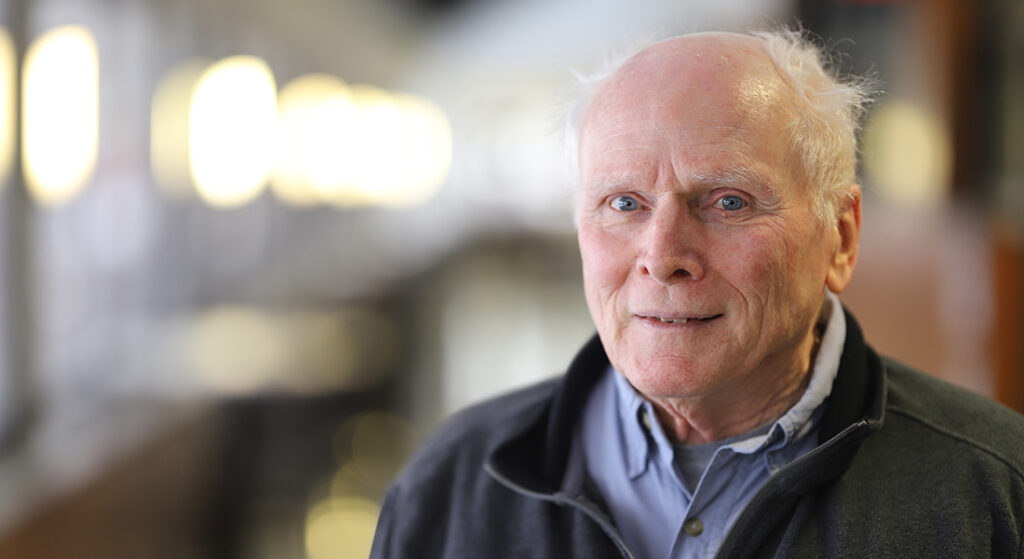
When it comes to lifelong learning, there’s no better example than Paul Ossenbruggen ‘63. With several decades of experience as a professor, and an engineering career spanning over 40 years, he continues to publish new research papers to this day. However, the journey towards settling into his teaching role took some time. With so many different things he enjoyed learning, it made choosing a specific career difficult.
“I never seem to settle in anything. Some people got involved with one thing and that’s what they do,” he says. “That’s not me – I jump around from one thing to the next.”
Graduating from Brooklyn Tech High School in 1959, Ossenbruggen was uncertain about his career path. Though he began studying civil engineering at Syracuse University, he remained open to exploring other options. At one point, he even considered becoming an airline pilot. It was only during his internship at an energy technology company, Babcock and Wilcox, that he finally discovered his passion for nuclear engineering.
“Babcock and Wilcox make huge boilers,” he says. “Even though I was a civil engineering student, I was getting more involved with nuclear engineering. It was challenging but interesting and I loved every second of it.”
After completing his undergraduate studies at Syracuse in 1963, he continued pursuing his interest in nuclear engineering when working at General Dynamics Electric Boat, where he helped build nuclear submarines. Yet, a part of him wanted to continue learning and exploring other options.
“I loved my job at Electric Boat. They designed and constructed the first nuclear-powered submarine, the U.S.S. Nautilus,” he says. “But I felt there was so much more I wanted to learn so I decided to go to grad school at the University of Connecticut in 1967 and later Carnegie Mellon University for my Ph.D. in 1970. I like learning new things.”
Initially planning to return to Electric Boat, Ossenbruggen became interested in higher education and decided to pursue teaching instead. He began teaching at Northeastern University in Boston, and later in 1975, he moved to the University of New Hampshire where he taught for 34 years. He also taught at the University of California, Berkeley from 2000-2003.
Teaching not only allowed him to mentor and guide students but also explore new engineering concepts, which he found fulfilling. During his tenure as a professor, he also wrote a textbook in 1984 titled “Systems Analysis for Civil Engineers.” The book combined the fundamentals of engineering economics and civil engineering systems and garnered critical acclaim at the time of its publication. It was also translated into Chinese.
“It was a cutting-edge book. Civil engineers didn’t usually write this kind of textbook,” he says. “And one of the great things about it is that it’s still being read to this day.”
Nowadays, Ossenbruggen has settled down, returning to Syracuse where he sees a bright future for the University and the city. He’s been particularly excited about Micron’s plans to invest an estimated $100 billion into Central New York as well as the community grid in downtown Syracuse.
“I’m excited to be in Syracuse now to see this transformation happen. Micron is going make a big difference,” he says. “I’ve been to every meeting, and it looks promising to me. This area turned into a rust belt but hopefully, it’ll become stainless steel.”
Ossenbruggen also looks forward to the Operations Research and System Analytics Master’s Program, which he believes will bring immersive learning to the college’s forefront and fuel students’ passion for learning and discovery.
“I’ve been interested in operations research since I was a grad student at Carnegie Mellon. It had just got off the ground when I was completing my Ph.D. I even proposed a similar course while I was at the University of New Hampshire.
“I’m glad ECS is committed to introducing this program. It’s interdisciplinary, which I like very much. The course selection is great and offers a nice variety of courses that can be tailored to meet a student’s interests. Syracuse University is in a great position.”
